Table of Contents
Ember Tetra: A Quick Summary
The Ember Tetra is a small, colorful fish native to the Amazon Basin in South America. It is known for its bright red and orange coloration and peaceful temperament. Ember Tetras are often kept in community aquariums and are omnivorous, accepting a variety of foods.
Ember Tetra Overview
Ember tetra is a tiny, freshwater, tropical fish that is native to the Araguaia River in Central Brazil. They were first discovered by Heiko Bleher. He named it Hyphessobrycon Amandae in honor of his mother, Amanda Bleher.
Ember tetras belong to a very diverse species of fish called the Characiformes, which have a total of 2000 fish across 19 families. It has become very popular among nano fish keepers in recent years because of its fiery appearance and playful nature. Because of this, it is also sometimes called the Fire Tetra. Despite its appearance, however, Embers are peaceful and not demanding. So they are a good choice even for those who have no or little experience in fish keeping.
In this article, we will run through everything you need to know about this cute and fun freshwater fish.
| Information Chart: | Ember Tetra |
| Scientific Name | Hyphessobrycon Amandae |
| Family | Characidae Family |
| Care Level | Very Easy |
| Temperament | Very Peaceful |
| Colour | Ranges between bright orange and a bright red |
| Lifespan | The average lifespan is about two years, but they can live up to three years |
| Size | Less than an inch (between 0.6 to 0.8 inches) |
| Diet | Omnivorous Diet |
| Minimum Tank Size | At least 10 gallons |
| Temperature | Between 73 and 84 degrees Fahrenheit (23 to 29 degrees Centigrade) |
| Water conditions | pH level should ideally be acidic with a pH near 6.6 |
| Tank Mate Compatibility | Compatible with other peaceful fish |
| Preferred Tank Set-Up | Freshwater tank with lots of plants and open spaces |
| Sexual Dimorphism | Females have bigger bodies and are generally plumper. Males are also usually more colorful especially when in spawning conditions. Also, females have a larger air bladder and their abdomen grows larger during the breeding period. |
| Lighting | Dimly Lit |
Ember Tetra Appearance :
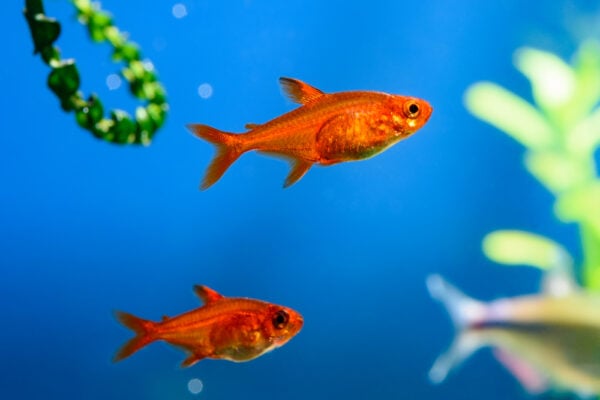
The popularity of the Ember Tetra has to be credited to its appearance. The bright fiery orange-ish red color that they exhibit is a stand-out in any aquarium. This vivid color is seen along the entire length of their body and gives them a distinct sharp look that cannot be missed.
They have tall and thin dorsal fins that slowly change to a slightly darker shade as it runs along the spine towards the rear. At the very edge of the fin, the color becomes nearly transparent. The caudal fins on an ember tetra are forked. The color change here is far more evident than on the dorsal fins. The color of the fin at the base is pretty much the same as the body. It then transitions into a dark orange along the fin before turning almost transparent at the edge. Their pectoral and ventral fins are also nearly transparent.
Talking about the body structure of the Ember Tetra, it resembles that of most other tetras. Wide and tall towards the front end, but slowly tapering towards the rear. This shape allows for swift and smooth movement through the water. In the upper part of the head, above the eyes and mouth, a reddish color can be observed. The scales on their body are also very closely arranged, making them look slightly transparent.
The Lifespan of an Ember Tetra :
The typical lifespan of an Ember Tetra is about 2 to 3 years.
There have been cases where sources have claimed that Ember Tetras live for almost 10 years. However, this information is very inaccurate. A long lifespan for an ember tetra would be 3 years if the quality of the environment that they live in and the care they receive are ideal.
Ember Tetra Size :
The typical Ember Tetra typically grows up to 0.6 inches on the lower end and 0.8 inches for larger specimens.
The Ember Tetra is not a very big fish. It is quite small and barely reaches the size of an inch even at its largest as an adult. This is smaller than its neon counterparts. This is an important distinction to observe as a lot of people think that these fish are all the same, just with different colors.
Natural Habitat and Origin :
The natural habitat of Ember Tetras is in the slow-flowing rivers, freshwater lakes, and swamps of Brazil, in the Araguaia River basin, and its tributary Rio das Mortes River. Their natural habitat has a large amount of vegetation at the bottom, which is also accompanied by a layer of fallen leaves and branches of trees.
The water usually has a soft, slightly acidic pH with a light yellow or brownish tint that is produced by the chemicals released during organic decay. The water is also usually dimly lit due to the presence of heavy vegetation.
The fish was first discovered in 1986 by the German Heiko Bleher who would popularize aquarium animal husbandry. He was also the first person to first describe the fish the following year. Heiko Bleher named the fish after his mother Amanda Bleher, a researcher.
Ember Tetra Care and Tank Set-Up :
Ember Tetra Tank Size and Specifications :
Optimum Tank Size for Ember Tetra :
The recommended tank size for Ember Tetra is 20 inches long, 10 inches wide, and 12 inches tall.
The ideal tank size for Ember Tetras is a minimum of 10 gallons, assuming you won’t be keeping more than 10 to 15 of them together. They are small fish and don’t require too much space. This is another aspect that makes them a very good fish to keep for beginner aquarists.
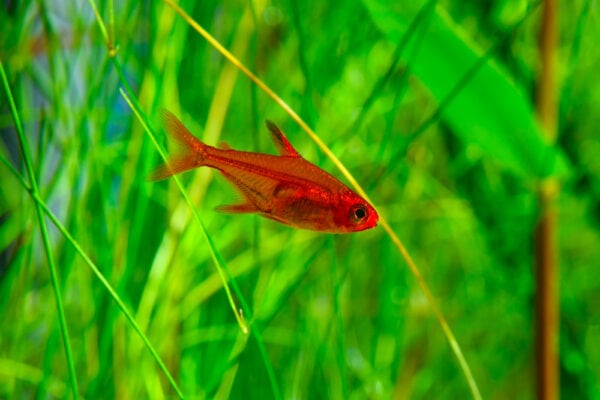
Filter Type :
To recreate the slow-moving water movement, use a silent filtration and aeration system. A regular sponge filter is perfect for this kind of setup. It will produce the ideal water flow for the Ember tetras without disturbing them.
Substrate :
Concerning the substrate, you can use any type. But if you want something visually impressive, we suggest using a dark one. You can also add dry leaves because they produce good bacteria that are beneficial for the fish.
How many Ember Tetras can be kept in a 10 gallon tank?
A 10-gallon tank can house anywhere between 10 to 15 Ember Tetras. This is a credit to their small size and peaceful temperament.
Water Parameters for Ember Tetras :
Water Temperature :
The ideal temperature for Peacock Gudgeons is between 73 and 84 degrees Fahrenheit (23 to 29 degrees Centigrade)
The temperature that the Peacock Gudgeon thrives in is usually in the range of 73 to 84 degrees Fahrenheit. This is pretty much the temperature that they experience in their natural habitat of the rivers and lakes in Brazil.
Water Flow Rate :
The ideal water flow rate for peacock gudgeons is the minimal possible setting that the pump offers.
The peacock gudgeon is not a very strong swimmer. Therefore, it needs a low water flow rate to keep the current to a minimum. The best way to deflect and reduce this current is by directing the flow right at the tank glass.
pH Level :
The perfect water pH level for the Ember Tetra is right around 6.6
Since they swim in areas with low pH levels, the recommended water parameters should have a pH level that is between 6.5 and 6.75. These are soft, slightly acidic water conditions.
Water Hardness:
The Ember Tetra is a fish that prefers to be kept in water that is slightly acidic and has adapted to a wide range of hardness between 5 – 17 dGH.
Ember Tetra Tank Landscape :
As would be evident to you by now, the Ember Tetra is a very small fish and does not need a lot of space. Also, taking into consideration their natural habitat in the freshwater lakes and slow-flowing rivers of Brazil, a small Aquascape of Nature Aquarium would be suited to the Ember Tetra. A lot of vegetation like floating plants, driftwood, and other vegetation would help recreate the natural habitat.
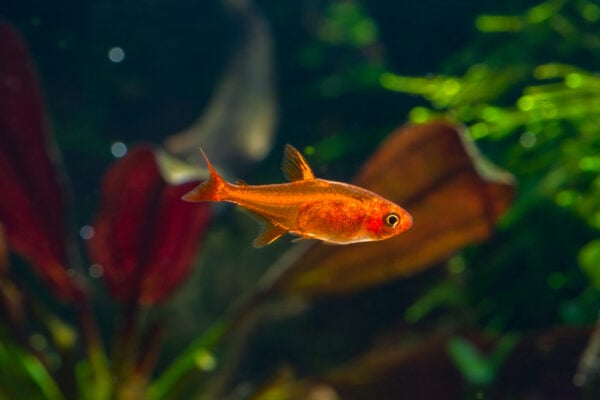
Best Plants for Ember Tetra Tanks :
The Araguaia River, where they come from, has layers of tree branches and fallen leaves covering the surface. These decaying leaves and branches cause the pH levels in the water to soften and allow only a little light to reach the bottom.
Therefore, the ideal tank condition for these fish should have similar conditions as their natural habitat. Some of the plants you can use our Java ferns, Java moss, Hornwort, Anacharis, Crypts, Bladderworts, Najas Grass, Peacock moss, and Duckweed.
These plants serve as their hiding place and food sources. They also protect their eggs during the breeding season. You can also add a few free-flowing plants and attach them firmly to the substrate. Just make sure not to overdo the plants, so the fish still have enough room to swim around.
Decorations for Ember Tetra Tanks :
The decorations and finishing touches in the tank for Ember Tetras should ideally have some rocks and wood. They are great fish to keep in planted Aquascapes like Iwagumi and Dutch Aquascapes. Make sure the tanks are populated heavily by plants and driftwood, as this will simulate a bit of their natural environment.
Lighting for Ember Tetra Tanks :
You should also place the aquarium in a dimly lit place. Avoid placing it in direct sunlight because it can stress Ember tetras. Their natural environment has a lot of vegetation and debris that creates shadows and reduces the amount of light they are exposed to.
Nitrogen and other Nutrient Requirements for an Ember Tetra Fish Tank :
The concentration of ammonia and nitrites in the water sees a sharp increase when fish in the tank produce waste. This accumulation of chemicals in your tank is hazardous to the fish. These chemicals need to be neutralized to maintain the quality of water in your tank and keep it in a hospitable environment. On average, the nitrogen cycle can take anywhere from 2 weeks to 2 months to be completed in the tank. Once the waste decomposes, the ammonia levels increase until they peak, and then start to decline. Now, the nitrate oxidizes the ammonia and leads to the formation of nitrite.
Feeding Ember Tetra :
Best Diet for Ember Tetra :
Ember Tetras, like most other fish, require an omnivorous diet to help meet their vitamin, protein, and other nutritional requirements. As they are omnivores, there is a wide range of foods that can be added to their diet. The best thing would be to balance their diet by including high-quality fish flakes or pellets, freeze-dried and frozen foods.
Make sure the fish are also given treats occasionally. Small live foods like bloodworms, brine shrimp, Tubifex Worms, Insect Larvae, Grindal Worms, Micro worms, and daphnia should serve this purpose. These foods also help bring in more vividness and bright color to the Ember Tetra.
That being said, don’t limit the regular nutrition source of the fish to only live foods. This has a chance of introducing certain parasites into the tank that might lead to contamination. Hence, use these live foods only as an occasional treat.
Also, be careful not to overfeed your Ember Tetra. They are small fish and overfeeding them is a far more common mistake than not feeding them enough. Overfeeding them might lead to them seeming lethargic and unenergetic throughout the day.
How often should you feed Ember Tetra? :
Ember Tetra should typically be fed 2 to 4 times a day.
However, you mustn’t overfeed them. Only give them enough food that they can eat in 2 minutes. Else, they are being overfed and the remaining food is going to waste.
Ember Tetra Behaviour and Temperament :
Are Ember Tetras lone or societal in nature?
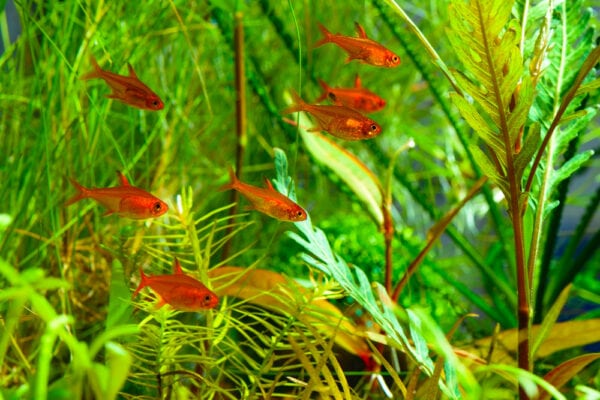
Ember tetras are community fish and they thrive better in schools. This is why it is highly recommended that you place at least 10 to 12 Ember tetras in the same aquarium. Seasoned fish keepers suggest that if you want to take care of Ember tetras, you need to have at least 7 or 8 of them in your aquarium. They are also compatible with other fish that have a peaceful temperament. Just make sure that they also have the same water requirements before adding them to the tank. Moreover, the Ember tetra also thrives when it has the company of other fish. It is highly recommended to make sure it has company, as the difference in their mood is noticeable.
Ember Tetra Ideal Tank Mates :
Neon tetras, rasboras, or dwarf cichlids, small Corydoras, honey gourami, Gold Tetra, and pygmy catfish are good companion fish for Ember Tetra.
Small Corydoras have the same size and temperament as the Ember tetras while neons and rasboras prefer to swim in a different water layer.
Ember tetras swim and feed in the middle layer. You can seldom find them picking food from the bottom. That’s why they can also live with pygmy catfish, which are known as bottom feeders.
You can also keep them in the same tank as certain bettas, as long as they both thrive in the same environment. As mentioned, Embers are a community fish, and they thrive better in schools. Also, Ember tetras are smaller than bettas, so there’s a possibility that if one of your Embers gets sick, bettas will eat them. Aside from these, there are no other problems between them living in the same tank. Since Ember tetras are middle layer swimmers, they stay out of the way of bettas. They also have the same food preference so feeding them is also not a problem.
Bad Tank Mates for Ember Tetra :
A few examples of tankmates that most definitely should not be kept with an Ember Tetra are :
- Angelfish
- Any type of carnivorous fish
- Clown Loaches
- Oscars
- Goldfish
- Cichlids
- Tiger Barb
- Koi
- Jack Dempseys
Breeding Ember Tetras :
When it comes to breeding, Ember tetras are free spawning so it’s not a difficult task at all. They also spawn more often. So, if there’s one thing to look out for, it should be how to control the process to increase the amount of fry. You need to separate the fry in a small, dimly lit tank that is weakly filtered.
To further stimulate Ember tetras to spawn, make sure that the pH level of your water is neutral and the temperature should be between 25°C and 27°C. Also, around two weeks before the spawning occurs, it is recommended to give the fish live food.
A clear sign that the fish are ready to breed is when the male starts to chase and nip the female while the female starts to show a larger abdomen as it is carrying eggs. The Ember Tetra also does not lay its eggs in any specific location. This means the eggs will usually just sink to the bottom of the tank.
Ember Tetra Breeding Level
- Very Easy
Ember Tetra Sexual Dimorphism :
To distinguish between male and female Ember Tetra, we just look at the shape and color of the fish. The females are usually a tad bit rounder than the males. This is because their abdomen increases in size when they carry eggs. The males typically show brighter and more vivid colors than the females.
Ember Tetra Common Diseases and their Treatment :
Some common health issues and diseases that we see in Ember Tetra are :
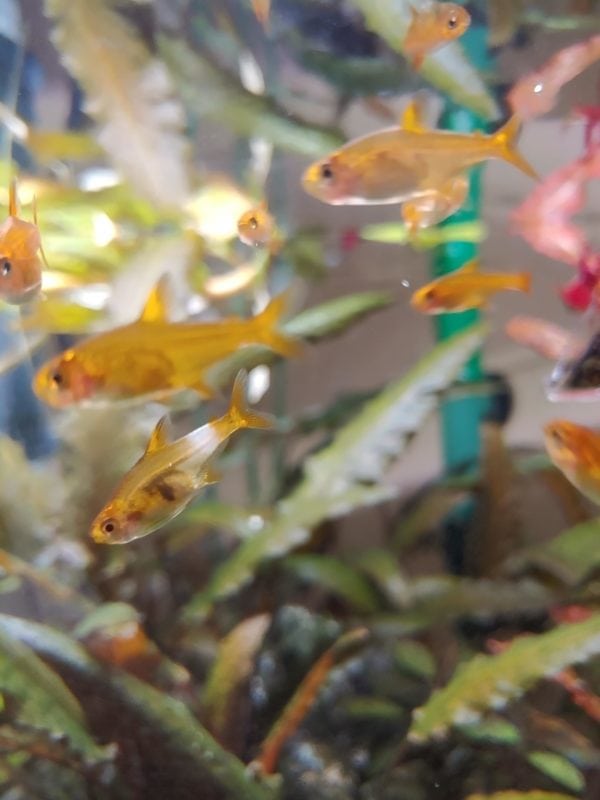
White Spot Disease :
This disease can be identified by the white spots that appear on the body of the fish. The major cause of this disease is usually stress experienced by the fish or improper maintenance of the water. The first step towards treating it would be to make sure that the water conditions are corrected. The fish itself can be treated by using over-the-counter medication and other products that treat the water in the tank.
Fungal and Bacterial Infections :
These diseases can be spotted by the observation of rotting fins and cloudy masses all over their body. These infections are critical as they can be fatal. Address these issues immediately. First, isolate the affected fish by quarantining it in a separate tank. Do a water change and vacuum the main tank as well to ensure the other fish do not get sick. Follow the specified medication procedure as recommended by the product. Even after the recovery, make sure that the fish is still quarantined for about a week before introducing it back into the main tank.
Impaction :
Blocking of the digestive tract happens when there is too much dry food that is ingested by the fish. It can be effectively prevented by including wet food in their diet. This can be done by soaking the food in water before giving it to the fish for feeding.
Facts about the Ember Tetra:
- They are quite small, and usually don’t grow larger than an inch in length
- They are a perfect beginner fish as they do not require advanced care techniques, and are quite easy to breed
- They are very peaceful community fish and do not cause a lot of problems with other fish in the tank
- They are some of the most popular fish, as they have bright and vivid color all over their body
- Compared to well lit environments, they prefer dim lighting
Are Ember Tetras Right for you?
Whether you are a seasoned or first-time fish keeper, Ember tetras are a good choice. They are compatible with other fish species and are also low maintenance. All you need to do is re-create their natural habitat. Once they acclimate to their new home, the Ember Tetra is a fish that can be cared for over a long period.
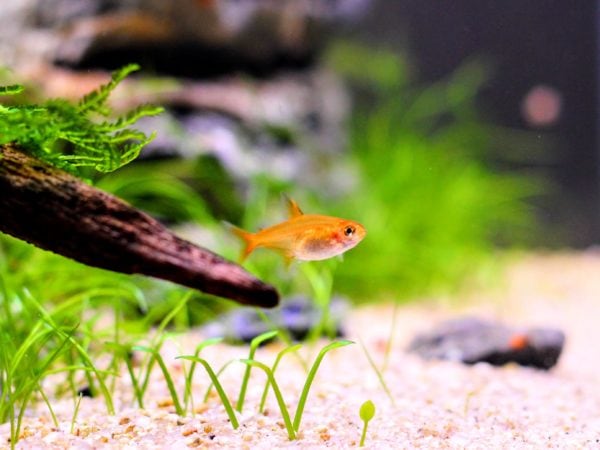
FAQ :
Does Ember Tetra like current?
Ember Tetra is a fish that comes from slow-moving waters. This means they prefer very mild currents. Keep this in mind when you choose a filter for your tank.
How many Ember Tetra can I put in a 10 gallon tank?
You can place anywhere between 10 to 15 Ember Tetras in a 10-gallon tank, but we recommend you put in slightly fewer. Around 5 to 8. If you want a larger group, then be sure to choose a larger tank.
Will an Ember Tetra nip a betta?
Ember Tetras are normally very peaceful fish and are not known to show this type of behavior. However, they may at times try to nip a betta or another fish with long fins.
How many Ember Tetra should be in a school?
A recommended school size for Ember Tetras is a range of 10 to 15 fish. Again, if you choose to have more, just make sure you have a larger tank to accommodate them.
How long do Ember Tetras live?
Ember Tetras usually live for a period of 2 to 4 years. This is based on the premise that they have access to ideal water conditions and are cared for properly.
How large do Ember Tetra grow?
Ember Tetras are quite small and they do not grow beyond the size of an inch. They usually grow to a size that lies between 0.6 to 0.8 inches as adults.
Conclusion:
The Ember Tetra is not a favorite just for us but for a lot of people out there. We also think it will be a perfect fit for you regardless of your experience in keeping fish. They are an ideal addition to any aquarium and will not disappoint. We wish you all the best of luck in your journey of keeping and caring for Ember Tetras!
No related posts.
